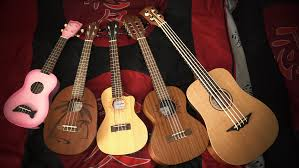When it comes to buying a ukulele there are thousands of options available all in different prices and styles. This variability can make finding the right instrument a challenge, especially for those who are new to making music. (Photo in public domain)
Buying a new ukulele can be tough, and there are thousands of models available in stores and over the internet that make finding the right instrument an overwhelming task.
This guide will help you narrow down your options and eventually decide on an instrument you will enjoy playing.
Finding The Right Price Range
Creating a budget is the first step to buying a new ukulele. “The typical price range for a ukulele can be anywhere from $70 to $7,000 depending on the brand, material and sound,” said Lily Meyer, a sophomore at Holly Springs High School via text. With such a large range of prices, it is important to know exactly how much you are willing to spend on your instrument.
The majority of high-quality ukuleles fall between $100 and $250. At this price range, you can find a wide variety of woods such as mahogany, rosewood, and maple. These woods have a small effect on the tone of your instrument. Ukuleles in this range are also built with sturdier hardware and are less prone to going out of tune or bow at the neck than their less expensive counterparts.
Most available ukuleles below $100 are built from plastic or inexpensive woods. When buying a low priced ukulele, oftentimes you are sacrificing sound for portability. These ukuleles tend to have a less clear sound and go out of tune more often than a higher-priced ukulele. However, lower-priced ukuleles do come in handy if you want an instrument you can tote around in a backpack, or bring outdoors without any worry.
Above the $250 threshold are the professional level ukuleles. These instruments are made of the highest quality woods and hardware. Oftentimes they are also made directly in the U.S. instead of being shipped in from other countries. Overall I would not recommend these ukuleles to anyone other than a seasoned player, especially seeing as an intermediate level ukulele is far cheaper and has the potential to sound almost the same.
Size
One of the main things that makes a ukulele unique from other instruments is its variability in size. There are five variations of the ukulele — from largest to smallest these styles are called the baritone, tenor, concert, pineapple, and soprano.
From left to right a soprano, pineapple, concert, tenor, and baritone ukulele. The larger the ukulele, the warmer and louder the sound. (Photo in public domain)
The size of a ukulele affects the sound, playability, and portability of the instrument. The larger the instrument, the louder and warmer it will sound. Large ukuleles like tenors and concerts are also a good choice if you have big hands or want to play songs involving high notes.
“For what it’s worth, I like tenor ukuleles. I have pretty big hands and long fingers, so the extra room on the fingerboard makes tenor ukes more comfortable. I also prefer the slightly bigger, fuller tone of a tenor uke,” said Sean the creator of the Beginner Ukuleles website.
On the other side of the spectrum, a small ukulele like a pineapple or soprano is the perfect size for taking on adventures. These ukuleles fit comfortably in a backpack and can easily go with you to the beach, on a hike, or even to school. Small ukuleles are also known to give off a “classic” ukulele sound.
“If your ukulele makes you happy then that’s great,” said Atticus Blum, a sophomore at Leesville Road High School via Google Meet. “…If it’s playable and it makes you happy then that’s all that I really care about. I know a lot of people who are out there who are sticklers about what kind of musical instrument you should get but I mean honestly as long as you have an instrument that you like and that feels comfortable for you to play.”

Hi! My name is Lauren! I’m President of the LRHS book club. Outside of school I’m a curler for Team Taylor and I like to rollerblade.


Leave a Reply